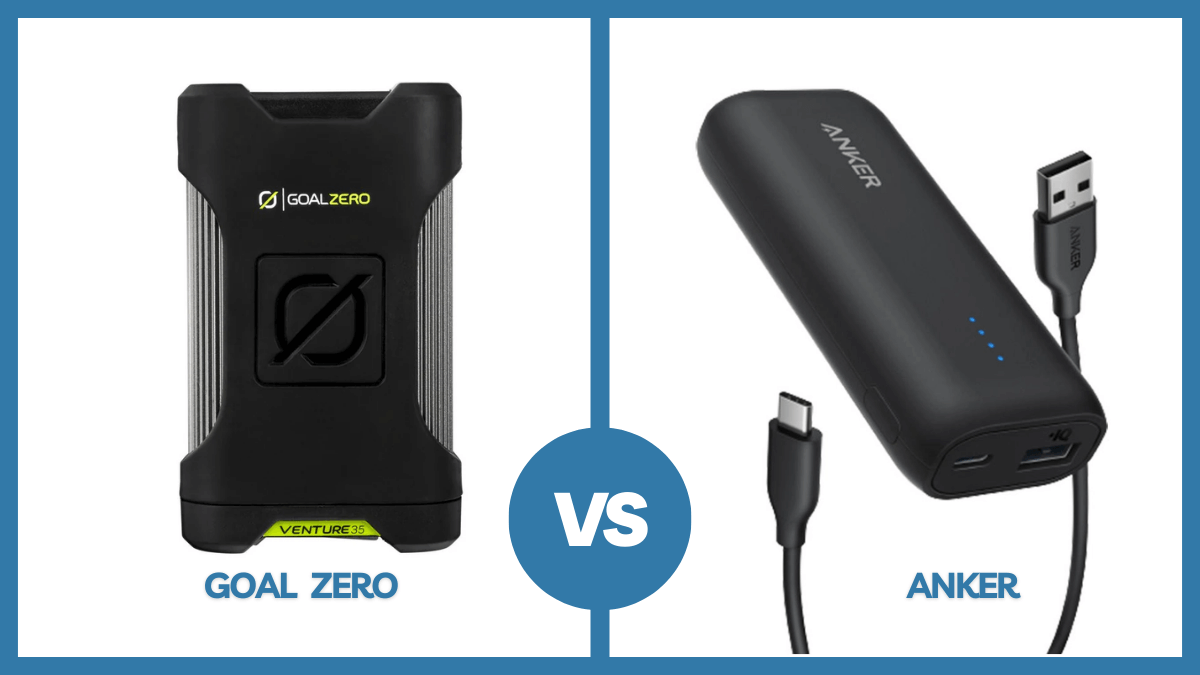Do you want to keep your cell phone topped up on the go? No worries, we jumped up with the best solution of portable solar chargers for you. Anker and Goal Zero are leading brands in power banks. They are offering high-quality products for on-the-go device power.
In this artice, we will walk you through the ultimate comparison between innovative solar energy packing brands Goal Zero vs Anker. Both have unique qualities suitable for charging your phones and laptops. Let’s delve into the amazing features of two fast-charging power packs.
Goal Zero VS Anker – Explore Ulitmate Features
Both Anker and Goal Zero are reliable power sources and play an important role in our daily lives as the cell phone is a crucial part of our lives. They are offering innovative portable power products with ultimate performance, features, and suitability.
| Features | Goal Zero | Anker |
|---|---|---|
| Design and Build Quality | Durable, foldable panels | Compact, weather-resistant |
| Portability | Portable solar panels | Lightweight, foldable |
| Performance | High conversion rates | High-efficiency solar panels, fast charging |
| Capacity | High-capacity power stations | Multiple capacities, small to large |
| Technology | Advanced batteries | Fast charging technology |
| Price and Value | Lightweight, durability | Budget-friendly, high performance |
Which one is most reliable, Goal Zero or Anker? Let’s dive into the amazing features of both standing-out brands to make well-informed decisions!
1. Design and Build Quality of Goal Zero and Anker
Goal Zero solar chargers are known for their durable construction with the features of foldable panels and portable power stations. These panels are made from reinforced nylon or aluminum frames.
Anker Solar Charger is a compact and durable device with weather-resistant polyester canvas and stainless steel eye holes. If you are an adventure lover and enjoy outdoor activities then it is perfect for you.
Read More: BLUETTI vs Jackery: Everything You Need to Know
2. Portability
Goal Zero offers portable solar panels and power stations for off-grid applications. Its energy packs ensure durability and performance for reliable power generation in remote locations.
Anker’s charger is lightweight, foldable, and ideal for outdoor activities like hiking and camping. Its lightweight design helps its users to carry in small bags. Its multiple ports allow you to charge multiple devices at the same time.
3. Performance: Anker Vs Goal Zero
Goal Zero chargers are designed for optimal efficiency with high conversion rates. They are integrated with portable power stations for future energy storage.
Anker uses high-efficiency solar panels which convert solar energy to usable electric energy. These chargers have amazing features of PowerIQ technology and foldable design for efficient energy conversion. These offer three USB ports for simultaneous device charging.
4. Capacity
If you are a remote worker then analyze the capability of both portable power stations, Goal Zero vs Anker makes your life easy by helping you select the best one. Goal Zero offers high-capacity power stations which are best for emergencies, camping, adventures, and off-grid living.
On the other side, the trending brand, Anker brand offers multiple capacities that are running from small to large. This is best for your everyday use.
5. Technology
With the advancement of technology, the usage of mobile phones is increasing day by day. With the high ratio of mobile usage, the chargers and power banks demand is increasing too.
For this, the goal company uses very advanced technology in their manufacturing. It provides well-advanced batteries and solar charging products in it. On the other hand, Anker is popular for its fast charging technology.
6. Price and Value
Goal Zero offers advanced features in their products such as lightweight, durability, and compatibility with their portable power solutions. This brand showcases its commitment to quality and innovation. Anker Solar Charger is budget-friendly. This brand’s products give high performance and offer excellent value for money.
Read More: Bluetti vs Goal Zero: A Comparative Review
FAQs
Which one is best, Goal Zero or Anker?
Anker’s portable power banks are lightweight and compact, perfect for travel and everyday use. Goal Zero’s portable power stations offer substantial capacity but may be bulkier and less convenient for frequent travel or commuting.
Is Anker the best brand for a power bank?
Anker is deemed the best power bank brand by ZDNET due to its portability, quality construction, and compatibility with both old and new devices.
Is Anker Apple certified?
Apple MFi certification verifies Anker accessories’ rigorous inspection and regulation by Anker Innovation. This feature ensures the safety and compatibility for Apple users. They can perform many actions with peace of mind.
What is the battery time of goal zero?
Goal Zero uses three types of batteries in their products, Lead-acid batteries, lithium batteries, and Yeti Lithium batteries. Lead-acid batteries have a lifespan of 200-300 cycles, lithium batteries 500-800 cycles, and Yeti Lithium batteries have a capacity of 500-80% after 500 cycles and ensure over 2000 life cycles.
Explore More!
Conclusion
This article explores the comprehensive difference between the portable power stations, Goal Zero vs Anker, and their ultimate features. The Anker and Goal Zero are reliable outdoor charging options with the latter offering affordability and portability.
Do not worry about your device charging, and make your outside journey hassle-free by buying the best products: USB C Charger and Goal Zero. To keep yourself updated about the latest advancements, visit more!

Leave a Reply